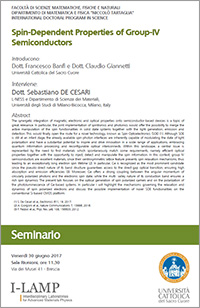- Brescia
- International Doctoral Program in Science
- News
- Spin-Dependent Properties of Group-IV Semiconductors
Spin-Dependent Properties of Group-IV Semiconductors

Venerdì 30 giugno 2017
Sala Riunioni, ore 11.30
Via dei Musei 41 - Brescia
Introducono:
Dott. Francesco Banfi e Dott. Claudio Giannetti
Università Cattolica del Sacro Cuore
Interviene:
Dott. Sebastiano DE CESARI
L-NESS e Dipartimento di Scienza dei Materiali,
Università degli Studi di Milano-Bicocca, Milano, Italy
Abstract
The synergetic integration of magnetic, electronic and optical properties onto semiconductor-based devices is a topic of great relevance. In particular, the joint implementation of spintronics and photonics would offer the possibility to merge the active manipulation of the spin functionalities in solid state systems together with the light generation, emission and detection. This would finally open the route for a novel technology, known as Spin-Optoelectronics (SOE) [1]. Although SOE is still at an infant stage, the already available spin-photon interfaces are inherently capable of modulating the state of light polarization and have a substantial potential to inspire and drive innovation in a wide range of applications, embracing quantum information processing and reconfigurable optical interconnects. Within this landscape, a central issue is represented by the need to find materials which spontaneously match some requirements, namely efficient optical properties together with the opportunity to inject, detect and manipulate the spin information. In this context, group IV semiconductors are excellent materials, since their centrosymmetric lattice feature prevents spin relaxation mechanisms, thus leading to an exceptionally long electron spin lifetime [2]. In particular, Ge is recognized as the most prominent candidate since the pseudo-direct nature of its band structure guarantees access to the direct-gap optical transition, ensuring high absorption and emission efficiencies [3]. Moreover, Ge offers a strong coupling between the angular momentum of circularly polarized photons and the electronic spin state, while the multi- valley nature of its conduction band ensures a rich spin dynamics. The present talk focuses on the optical generation of spin polarized carriers and on the polarization of the photoluminescence of Ge-based systems. In particular I will highlight the mechanisms governing the relaxation and dynamics of spin polarized electrons and discuss the possible implementation of novel SOE functionalities on the conventional Si-based CMOS platform.
[1] S. De Cesari et al., Electronics 6(1), 19, 2017.
[2] A. Giorgioni et al., Nature Communications 7, 13886, 2016.
[3] F. Pezzoli et al., Phys. Rev. Lett. 108, 156603, 2012.
La locandina (pdf)
